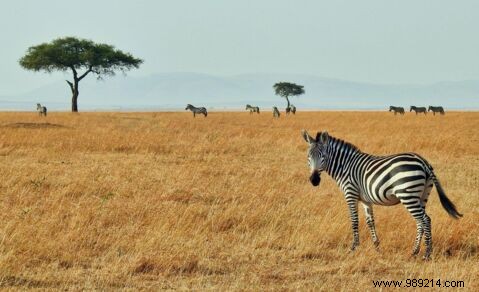Taking perfect landscape photos is possible with a smartphone. Follow our guide to taking great photos and follow our tips to improve them through post-production.
It's all about setting up your smartphone camera and good post-production. Thus, you have to be vigilant at three different times, the staging (lighting, positioning, etc.), the setting of the camera and finally the processing of the photo in post-production.
To take beautiful landscape photos with a smartphone, it is essential to focus on shooting. There are a few framing rules to photograph landscapes. If you want your photos to be perfect, follow our guide.
Never put the horizon line in the center of your composition:Why? Because it allows you to better support the depth and bring texture to your photograph taken with your smartphone. As with portraits, there is the rule of thirds. You have to imagine a grid that divides your composition into three . Because of this, you should place the horizon line on the bottom line. However, you can be transgressive to highlight the texture of a sky, the surface of water or even arid land.
Let's take an example, for a landscape with many cumulonimbus clouds in the sky, you should place the horizon line at the bottom of the composition . This will give a gigantic dimension to your image while letting the clouds dominate the photograph. If there is a body of water in the foreground, you must instead place the horizon line at the top of your composition. This placement will emphasize the reflections of the water in your composition.
Now you know how shooting is done. This is actually the important factor to learn and understand to achieve a perfect landscape photo s with your smartphone.
What is a line of flight? The vanishing lines are used to guide the gaze and thus give relief to the photographs. It is thanks to perspective that these lines appear wider in the foreground. It has the consequence that we follow the line with our gaze to the interior of the image.
This is the case, for example, for a wall, a ramp etc To properly achieve a line of flight, you must place these elements close enough to your lens to emphasize perspective. These elements will be primers to your photo, they will give a more modern look just a simple landscape photo. As you will have understood, these vanishing lines give depth and draw the eye to the horizon line and give dynamism to the image.
This rule may seem logical to you and yet, the time of day that you choose to take a photo with your smartphone is as important as a setting. The light that composes photography precisely differentiates a beautiful photo from a simple banal photo. Early in the morning and in the evening, the light is softer . Indeed, it tints the sky with shades of orange and gold. On the contrary, in the middle of the day, the light crushes! It is too hard and does not necessarily restore the reliefs.
In photography, we call "Golden Hour" or in French "golden hour" , the time of day when the light is very colorful. These times are at sunrise and sunset. During these moments, the hues are predominantly orange , yellow or pink. Also, the shadows are softer and less aggressive than the rest of the day. The Golden Hour will give your landscape photos a warm atmosphere, this time of day is also very popular with professional and amateur photographers. It is true that these colors make it possible to embellish a landscape and highlight the perspectives and the reliefs thanks to the play of colors. There is no specific time for golden hour, but be aware that it is at sunrise or sunset. However, start from the principle of going to the place, one hour before sunrise and sunset . Be careful, this moment only lasts a handful of seconds.
The notion of scale makes it possible to emphasize the grandiose side of the landscape . A few silhouettes present in a landscape will give this notion of scale for example. They come to betray this side “lost in nature”. Human silhouettes are very good scale markers, but not only! Animals for example (wild or domesticated) can be "exploited" in order to add a scale mark to your photograph.
For example, faced with the immensity of a tree or a large rock, the silhouette of an animal seems very small. Not to mention the fact that animals give authenticity to the landscape. Finally, houses, roads, villages are also elements that allow you to include a scale in your photo. We can easily see the dimensions of the landscape thanks to the width of the road, the size of the house, the village etc.

If your phone allows it, shoot in Raw. What is Raw for? It is a file that keeps all the information of your sensor. Your smartphone does not automatically process the information forcing a final rendering of the snapshot. Shooting in Raw avoids too saturated processing of colors at the time of shooting. This allows in post production to have, for example, not a very black black, but more a palette of grays. It allows you in post production to bring blue in your shadows, to get more details.
You can also use an HDR photography app . What is HDR? This is the High Dynamic Range. It is a video and photo capture technique. The application will automatically make 3 separate settings for the same shot:
Then an HDR treatment will take the best of each photographic exposure to render it in a single image.
On your favorite computer, you can process HDR files and work with different renderings. It will combine underexposed, normally exposed, and overexposed photos; The application will draw more nuances, more details , avoiding burning the whites, oversaturating the blacks. Pre-settings or even your action on the intensity and luminosity will give different renderings possible:from realism to impressionism. Your images will be deeper, more detailed, closer to what the human eye can pick up. Sometimes they will even have a perfectly surreal character.
Many applications exist for your computer:Aurora HDR, Luminance HDR and others. There are even online solutions. So much for the tips, but above all, above all, with your computer… have fun! And you will be surprised with some results.
To rework your photos, you need an efficient and modern computer . The DELL XPS 13 model has all the features you need to work perfectly on your landscape and portrait photography in post-production. Consult our guide to work optimally on your portrait photos.
Dell XPS laptop

Dell has a special student discount program! The Dell Advantage Program offers students a discount of up to 45 %. Please note, the offer is limited in time, it is valid until July 27, 2021. So don't hesitate to take advantage of the 45% discount on high-end systems and accessories that will accompany you throughout your studies. . Signing up is simple and delivery is free for all students .
To benefit from this reduction, you must be a student over 18 years old enrolled in a higher education establishment (including professional training establishments). All you have to do is provide Dell with your student email address and a copy of your student card. In less than 72 hours, an answer will be brought to you. And voila, you will have access to the entire catalog at a reduced price!
Small bonus: You can also benefit from a double reduction up to 500 euros with the trade-in and refund program that can be combined with the Dell Advantage offer. And 45% in addition to a reduction is not negligible, it will allow you to offer for example a weekend to attend the Festival des Vielles Charrues!
Once the post-production of photos is complete, you are at the last stage, that of publishing the image. Depending on the Smartphone, the images can have gigantic formats. To do this, you will need to resize your image . It's up to you to choose the output format according to its destination:the web, print, slideshow, etc. In addition to resizing, you have to think about the definition of the image . We then speak of ppi or dpi. It will then be necessary to adjust the sharpness of the photo as well as the colorimetric profile.